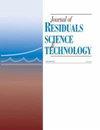氨氧化细菌富集及微生物多样性高通量测序分析
引用次数: 3
摘要
以某污水处理厂A2/O工艺获得的活性污泥为种子污泥,在全自动微型发酵罐上富集氨氧化菌(AOB)。结果表明,间歇式连续供氨模式可丰富AOB群落,适当调节游离氨(FA)和游离亚硝酸盐(FNA)水平。最大氨氧化速率大于170 mg/ (L·h),亚硝酸盐积累率大于80%。高通量测序结果显示,亚硝基单胞菌属AOB, 27天后富集,从0.24%增加到53.03%。本文章由计算机程序翻译,如有差异,请以英文原文为准。
Enrichment of Ammonia-Oxidizing Bacteria and Microbial Diversity Analysis by High-Throughput Sequencing
A fully automatic miniature fermenter was operated to enrich ammoniaoxidizing bacteria (AOB) using the activated sludge obtained from the A2/O process in a wastewater treatment plant (WWTP) as the seed sludge. The results revealed that the AOB community can be enriched by a continuous ammonia feeding mode for intermittent operation, resulting in the appropriate regulation of free ammonia (FA) and free nitrous acid (FNA) levels. The maximum ammonia oxidation rate was over 170 mg/ (L·h) and nitrite accumulation ratio over 80%. High-throughput sequencing showed that Nitrosomonas belonging to AOB, were highly enriched after 27 days, having increased from 0.24% to 53.03%.
求助全文
通过发布文献求助,成功后即可免费获取论文全文。
去求助
来源期刊

Journal of Residuals Science & Technology
环境科学-工程:环境
自引率
0.00%
发文量
0
审稿时长
>36 weeks
期刊介绍:
The international Journal of Residuals Science & Technology (JRST) is a blind-refereed quarterly devoted to conscientious analysis and commentary regarding significant environmental sciences-oriented research and technical management of residuals in the environment. The journal provides a forum for scientific investigations addressing contamination within environmental media of air, water, soil, and biota and also offers studies exploring source, fate, transport, and ecological effects of environmental contamination.
 求助内容:
求助内容: 应助结果提醒方式:
应助结果提醒方式:


